AUDI A3 2012 Owner´s Manual
Manufacturer: AUDI, Model Year: 2012, Model line: A3, Model: AUDI A3 2012Pages: 280, PDF Size: 70.11 MB
Page 121 of 280
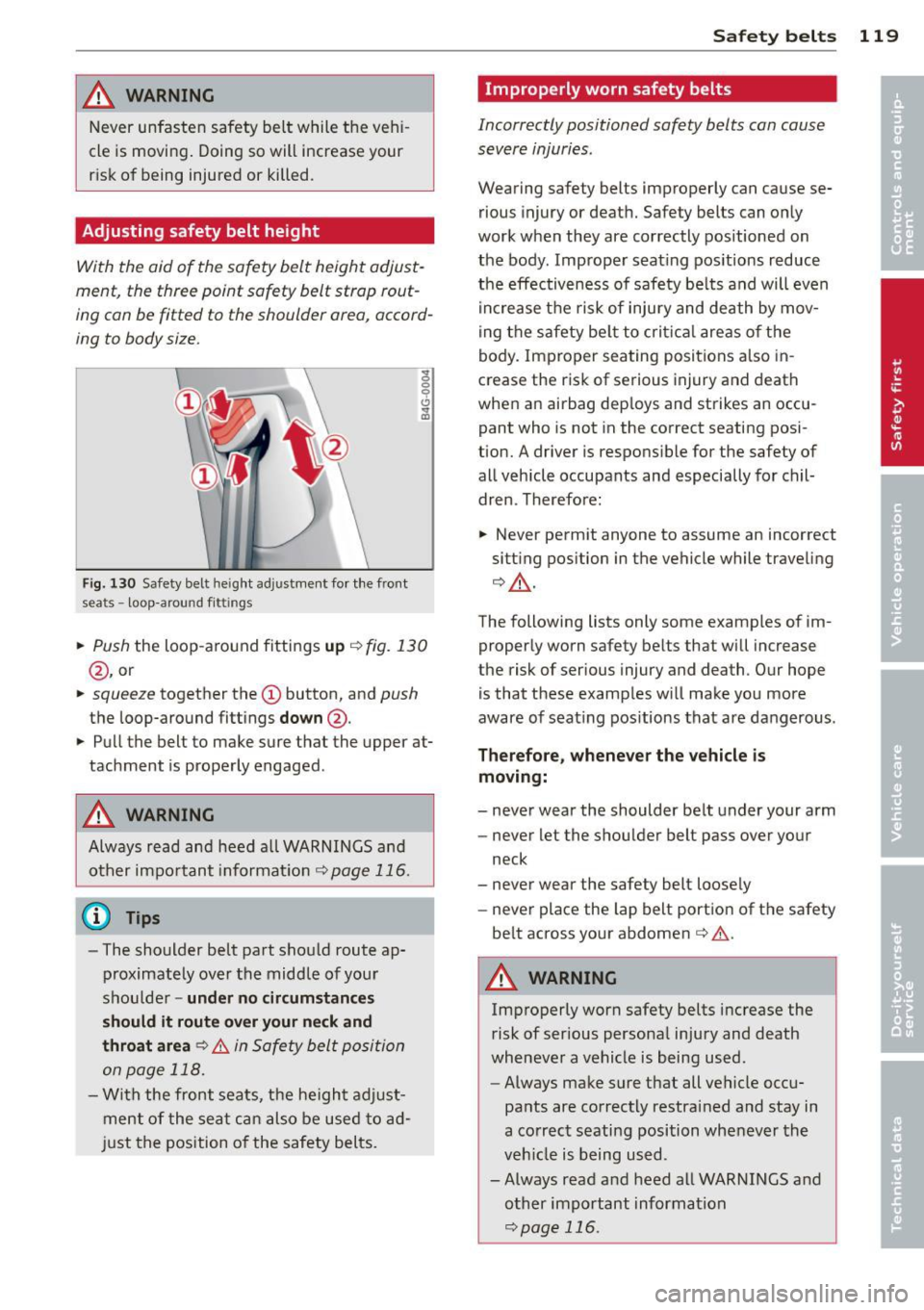
,&_ WARNING
Never unfasten safety belt while the vehi
cle is movi ng . Doing so will increase your
risk of being injured or killed .
Adjusting safety belt height
With the aid of the safety belt height adjust
ment, the thr ee point safety belt strap rout
ing can be fitted to the shoulder area, accord
ing to body size.
Fi g. 13 0 Safety be lt heig ht ad justment fo r the fr ont
s e ats - loop -a ro un d f ittin gs
g 0 0 0 ... a,
• Push the loop -aro und fitti ngs up ¢ fig. 130
@ , or
• squee ze together the (D button, and push
the loop-around fitt ings down @.
• Pull the belt to make sure that the upper at
tachment is properly engaged .
_&. WARNING
Always read and heed all WARNINGS an d
ot her i mpo rtant in format io n
¢ page 116.
(D Tips
-The sho ulder belt part sho uld route ap
pro ximately over the middle of your
shou lde r -
under no circum stances
should it route over your neck and
throat area
¢ .&. in Safety belt posi tion
on page 118.
- Wi th the fr ont seats, the he igh t adju st
me nt of the se at c an a lso be used to ad
ju st the position o f the safety belts.
Safety belts 119
Improperly worn safety belts
Incorrectly positioned safety belts can cause
severe injuries .
Wearing safety belts improperly can cause se
rious injury or death. Safety belts can on ly
work when they are correctly positioned on
the body . Imprope r seat ing pos itions reduce
the effectiveness of safety be lts and will
even
inc rea se t he risk of inju ry and death by mov
in g t he safety be lt to c riti cal a reas o f the
bo dy. Improper seating posi tions a lso in
c rease the ris k of serious injury and death
when a n airbag dep loys and strikes an occu
pant who is not in the correct seating posi
tion. A driver is respons ible for the safety of
all vehicle occupants and especially for ch il
dren . Therefore:
• Never perm it anyone to assume an incorrect
sitt ing pos ition in the vehicle while traveling
¢ _& .
The following lists only some examples of im
proper ly worn safety belts that will increase
the risk of ser ious injury and death . Our hope
is that these examp les w ill make you more
aware of seat ing pos itions that are dangerous .
Therefore, whenever the vehicle is
moving:
- never wear the shoulder belt under your arm
- never let the s hou lder belt pass over yo ur
neck
- never wear the safety belt loose ly
- neve r place the lap belt port ion of the safety
be lt across your abdomen¢.&. .
_&. WARNING
Im properly worn safety belts increase the
risk of ser ious persona l injury and death
whenever a vehicle is being used .
- Always make s ure t hat all vehicle occu
pa nts are co rrectly restra ined and stay in
a co rrect seati ng position whe never th e
veh icle is being used.
- A lways read and heed a ll WARNIN GS and
o th er impo rtant information
¢ pag e 116 .
Page 122 of 280
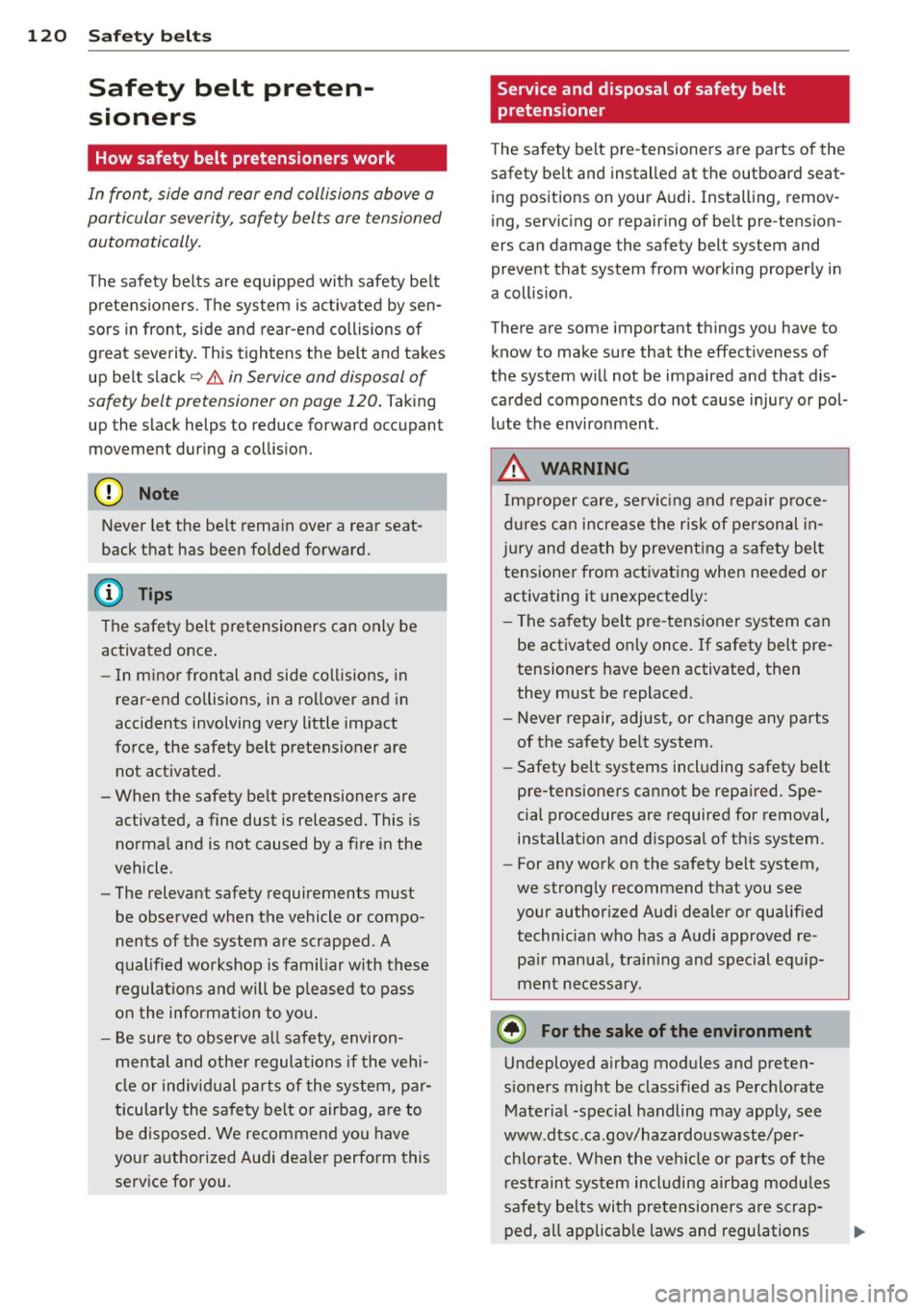
120 Safety belts
Safety belt preten
sioners
How safety belt pretensioners work
In front, side ond rear end collisions above a
particular severity, safety belts are tensioned automatically.
The safety belts are equipped with safety be lt
p retensioners. The system is activated by sen
sors in front, side and rear-end collisions of
g reat severity. This tight ens the belt and takes
up be lt slack ~
& in Service and disposal of
safety belt pretensioner on page 120 .
Taking
up the slack helps to reduce forward occupant
movement during a collision.
Never let the be lt remain over a rear seat
back that has been folded forward.
The safety be lt pretensioners can only be
activated once.
-In m inor frontal and side coll isions, in
rear-end collisions, in a rollover and in
accidents involving very little impact
force, the safety belt pretensioner are
not act ivated.
- When the safety belt pretensioners are
activated, a fine dust is released. This is
normal and is not caused by a f ire in the
vehicle .
- The relevant safety requirements must
be observed when the vehicle or compo
nents of the system are scrapped . A
qualified workshop is familiar with these
r egulations and will be pleased to pass
on the information to you.
- Be sure to observe all safety, environ
mental and other regulations if the vehi
cle or indiv idual pa rts of the system, par
ticularly the safety belt or airbag, are to
be disposed. We recommend you have
your a uthorized Audi dealer perform this
serv ice for you .
Service and disposal of safety belt
pretensioner
The safety belt pre-tensioners are parts of the
safety belt and installed at the outboard seat
ing pos itions on your Audi. Installing, remov
ing, servicing or repairing of be lt pre-tension
ers can damage the safety belt system and
prevent that system from working properly in
a coll is ion.
There are some important things you have to
know to make sure that the effectiveness of
the system will not be impaired and that dis
carded components do not cause injury or pol
lute the environment.
,&. WARNING
Improper care, servicing and repair proce
dures can increase the risk of personal in
jury and death by preventing a safety belt
tensioner from activating when needed or
activating it unexpectedly:
- The safety be lt pre-tensioner system can
be activated on ly once. If safety belt pre
tensioners have been activated, then
they must be replaced .
- Never repair, adjust, or change any parts
of the safety be lt system.
- Safety belt systems including safety belt
pre-tensioners cannot be repaired. Spe
cial procedures are required for removal,
installation and disposal of th is system.
- For any work on the safety belt system,
we strongly recommend that you see
your authorized Audi dealer or qualified
technician who has a Audi approved re
pa ir manual, train ing and special equ ip
ment necessary .
@ For the sake of the environment
Undeployed airbag modules and preten
sioners might be classified as Perchlorate
Material -special handling may apply, see
www .dtsc.ca .gov/hazardouswaste/per
chlorate. When the veh icle or parts of the
restraint system including airbag modules
safety be lts with pretensioners are scrap-
ped, all applicab le laws and regulations .,.
Page 123 of 280
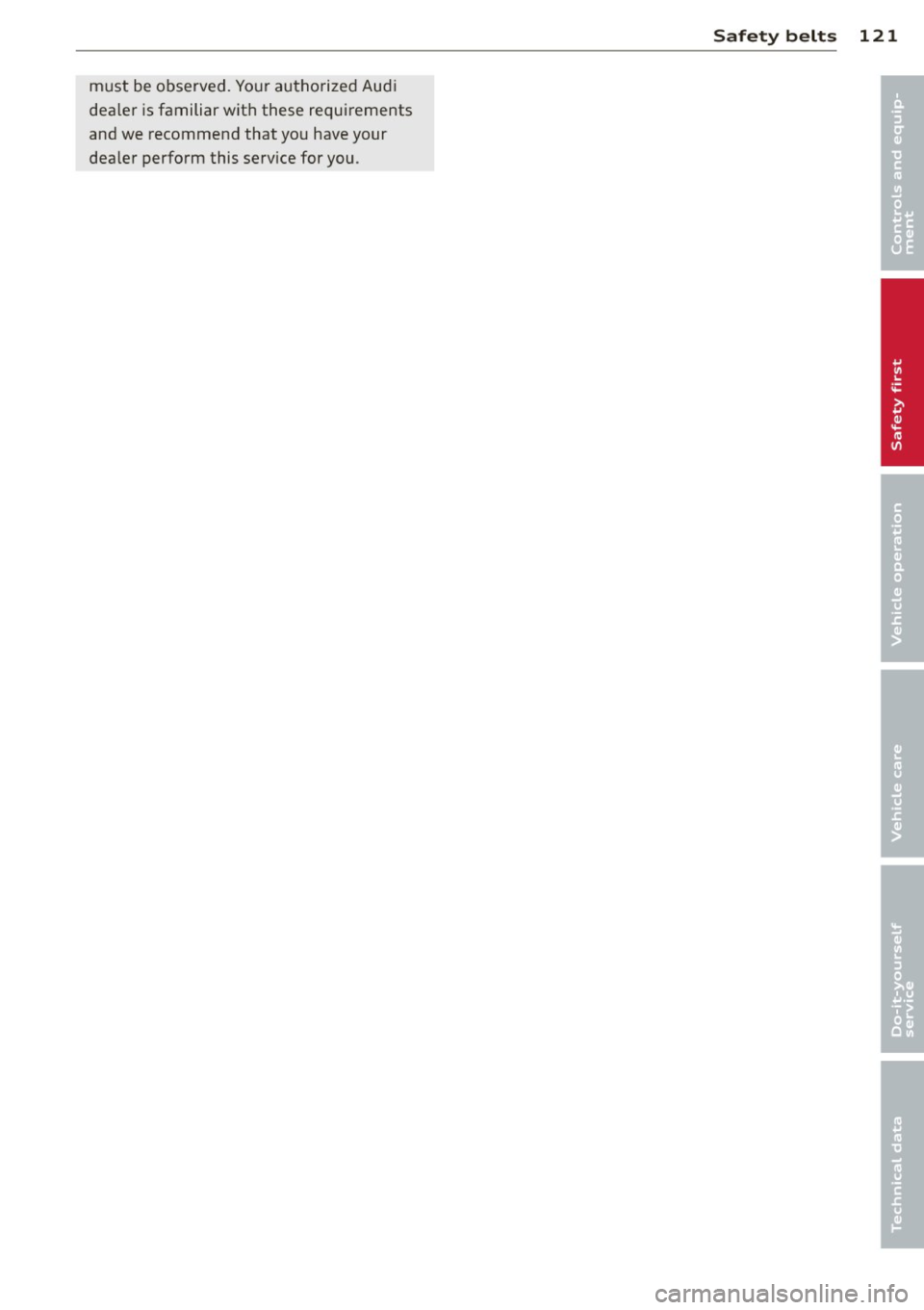
must be observed. Your authorized Audi
dealer is familiar with these requirements
and we recommend that you have your
dealer perform this service for you.
Safety belts 121
•
•
Page 124 of 280
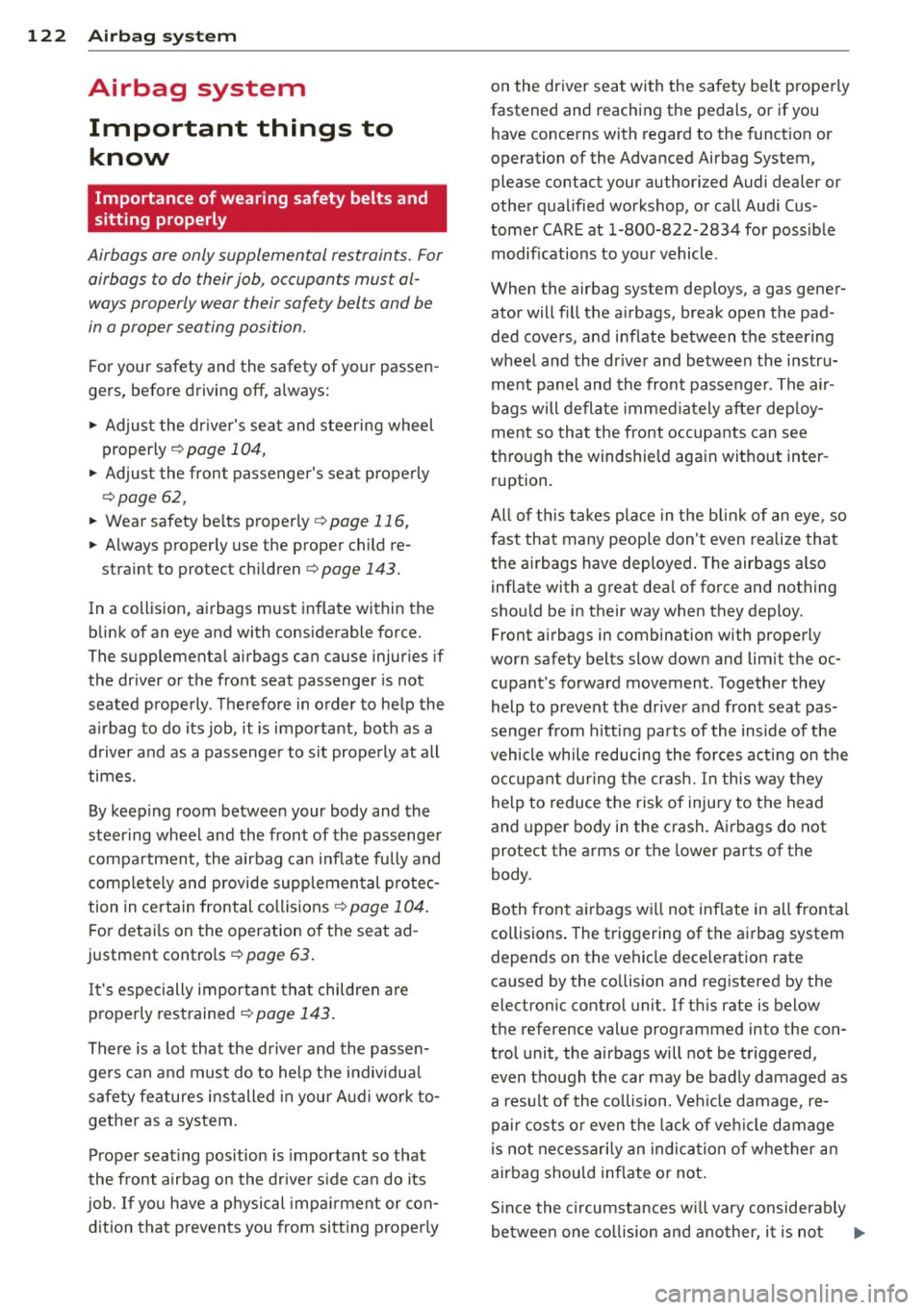
122 Airbag sys te m
Airbag system
Important things to know
Importance of wearing safety belts and
sitting properly
Airbags are only supplemental restraints. For
airbags to do their job , occupants must al
ways properly wear their safety belts and be
in a proper seating position.
F or your safety and the safety of your passen
gers, before driving off, always:
• Adjust the dr iver's seat and steering wheel
properly ¢
page 104,
• Adjust the front passenger's seat properly
¢page 62,
• Wear safety be lts properly ¢ page 116,
• Always properly use the proper child re-
stra int to protect children¢
page 143.
In a collision, airbags must inflate within the
blink of an eye and with considerable force .
The supplementa l airbags can cause injuries if
the dr iver or the front seat passenger is not
seated properly . Therefore in order to he lp the
a irbag to do its job, it is important, both as a
d river and as a passenge r to sit properly at all
times.
By keeping room between your body and the
steering wheel and the front of the passenger
compartment, the airbag ca n inflate fully and
comp letely and provide supp lemental p rotec
tion in ce rtain frontal collisions¢
page 104.
For detai ls on the operation o f the seat ad
justment contro ls
¢ page 63.
It 's especially important that children a re
properly restrained ¢
page 143.
There is a lot that the driver and the passen
gers can and must do to help the individual
safety features installed in your Audi work to
gether as a system.
Prope r seat ing pos ition is important so that
the front airbag on the drive r side ca n do its
job. If yo u have a physical impa irment or con
d ition that p revents you from sitt ing proper ly on the driver seat with the safety belt properly
fastened and reaching the pedals, or if you have concerns with regard to the function or
operation of the Advanced Airbag System,
please contact your author ized Audi dealer or
other qualified workshop, or ca ll Audi Cus
tomer CAR E at 1-800-822-2834 for possible
modifications to your vehicle .
When the airbag system deploys, a gas gener ator will fill the a irbags, break open the pad
ded covers, and inflate between the steering
whee l and the dr iver and between the instru
ment pane l and the front passenger. The a ir
bags will defla te immed iately after dep loy
me nt so that the front occupants can see
t h rough the windshie ld again witho ut inter
ruption.
All of th is takes place in the b lin k of an eye , so
f ast that many peop le don't even realize that
the ai rbags have deployed. The airbags a lso
inflate with a g reat deal of force and nothing
shou ld be in their way when they deploy.
Front a irbags in combination with properly
worn safety belts slow down and lim it the oc
cupant's forward movement. Together they
help to prevent the driver and front seat pas
senger from hitting pa rts of the inside of the
vehicle while reducing the forces act ing on the
occupant dur ing the crash. In this way they
help to reduce the risk of injury to the head
and upper body in the crash. Airbags do not
protect the arms or the lower parts of t he
body.
Both front airbags w ill not inflate in all fronta l
co llisions . The triggering of the a irbag system
depends on the vehicle dece leration rate
caused by the co llision and registered by the
electron ic control unit. If th is rate is below
the reference value programmed into the con
trol unit , the airbags will not be triggered ,
even though the car may be badly damaged as
a resu lt of the co llision . Ve hicle damage, re
pair costs o r even the lack of ve hicle damage
is not necessari ly an indica tion of whether an
airbag shou ld inflate or not .
S ince the circumstances wi ll vary considerably
betwee n one co llision and ano ther, it is not .,.
Page 125 of 280
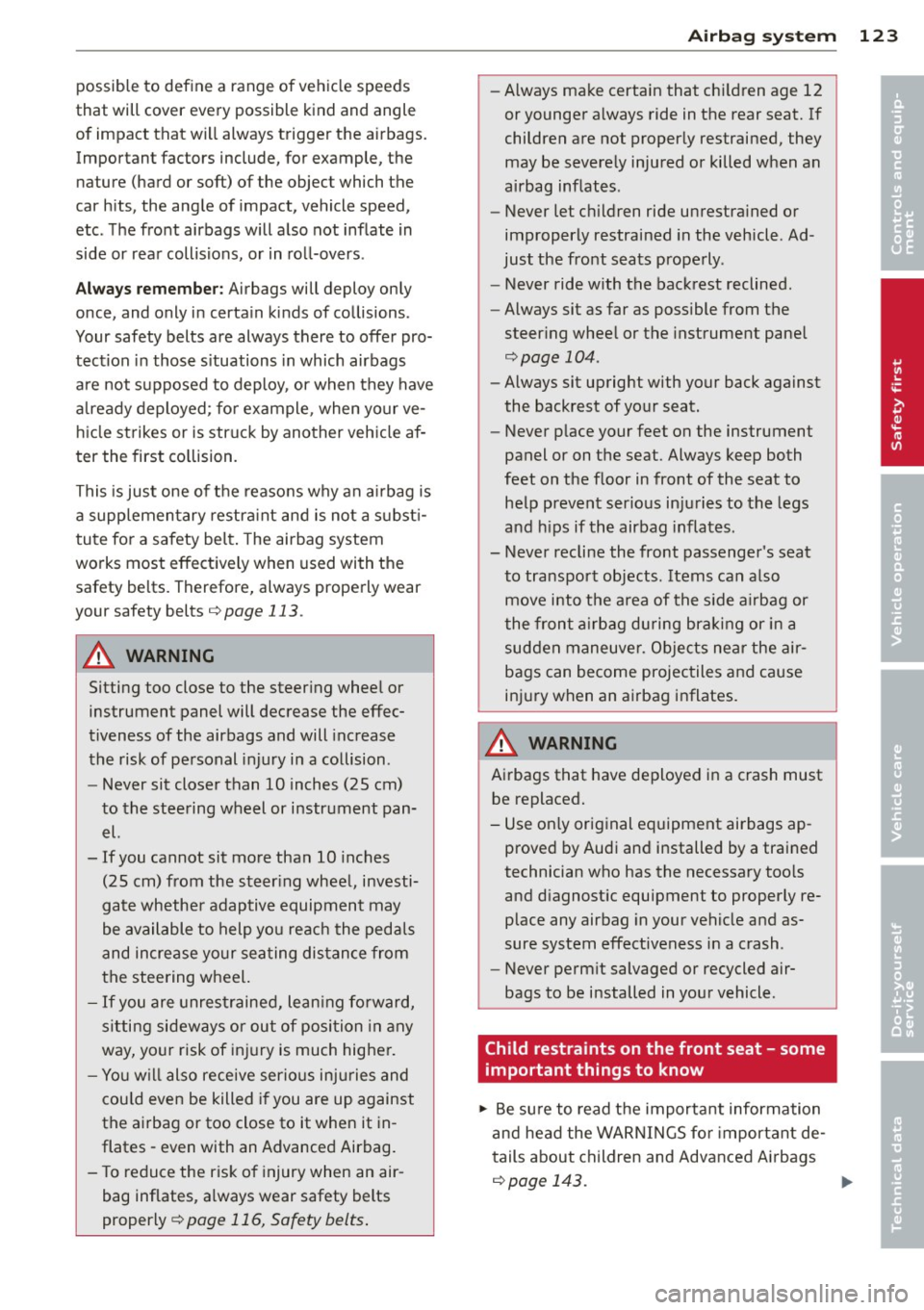
possible to define a range of vehicle spee ds
that will cover every possible kind and angle
of impact that will always trigger the a irbags .
Important fact ors include, for example, the
nature (hard or soft) of the object which the
car hits, the angle of impact, vehicle speed,
etc. The front airbags will also not inflate in
side or rear collisions, or in ro ll-overs .
Alw ay s rem ember : Airbags will deploy only
once, and only in certa in kinds of collisions .
Your safety belts are always there to offer pro
tection in those s ituation s in which airbags
are not supposed to deploy , or when they have
a lready deployed ; fo r example , when yo ur ve
h icle strikes or is struck by another veh icle af
ter the first co llision.
This is just one of the reasons why an a irbag is
a supplementary restra int and is not a s ubst i
tute for a safety belt . The airbag system
works most effectively when used with the
safety belts. Therefore, always properly wear
your safety belts¢
page 113 .
A WARNING
Sitting too close to the steer ing wheel or
instrument panel will decrease the effec
tiveness of the airbags and will increase
the risk of personal injury in a co llision .
- Never sit closer than
10 inches (25 cm)
to the steering wheel or instrument pan el.
- If you cannot sit more than
10 i nches
(25 cm) from the steer ing wheel, investi
gate whether adaptive equipment may
be available to help you reach the pedals
and increase your seating dis tance from
the steering wheel.
- If you are unrestrained, lean ing fo rward,
sitting sideways or out of position in any
way, yo ur risk of inj ury is much highe r.
- You w il l also receive serio us injuries and
cou ld even be killed if you are up against
the airbag or too close to it when it in
flates -even with an Advanced Airbag.
- To reduce the r isk of injury when an air
bag inflates, a lways wear safety belts
properly ¢
page 116, Safety belts .
Airbag system 123
-Always make certain that chi ld ren age 12
or younger a lways ride in the rear seat. If
children are not properly restrained, they may be severe ly inju red or killed when an
airbag inf lates .
- Never let ch ildren ride unrestra ined or
improperly restrained in the vehicle . Ad
just the front seats prope rly .
- Never ride with the backrest reclined.
- Always sit as far as possible from the
steer ing whee l or the instrument pane l
¢page 104.
-Always sit upright with your back against
the backrest of your seat.
- Never p lace your feet on the instrument
panel or on the seat. Always keep both
feet on the f loor in front of the seat to
he lp prevent serio us in ju ries to the legs
and h ips if the airbag inflates.
- Never recline the front passenger 's seat
to transport objects. Items can a lso
move into the area of the s ide a irbag or
the front a irbag du ring bra king or in a
sudde n maneuve r. Obje cts ne ar the air
bags can become projectiles and cause
injury when an airbag inflates.
_&. WARNING ~
A irbags that have de ployed in a crash must
be replaced.
- Use on ly original equipment airbags ap
proved by Audi and installed by a trained
technician who has the necessary too ls
and d iagnost ic equipment to properly re
place any airbag in your vehicle and as
sure system effectiveness in a crash .
- Never perm it salvaged or recycled air
bags to be installed in your vehicle .
Child restraints on the front seat - some
important things to know
.,. Be su re to read t he important information
a nd head the WAR NINGS fo r important de
t ails about children and Advanced A irbags
¢ page 143. ..,.
•
•
Page 126 of 280
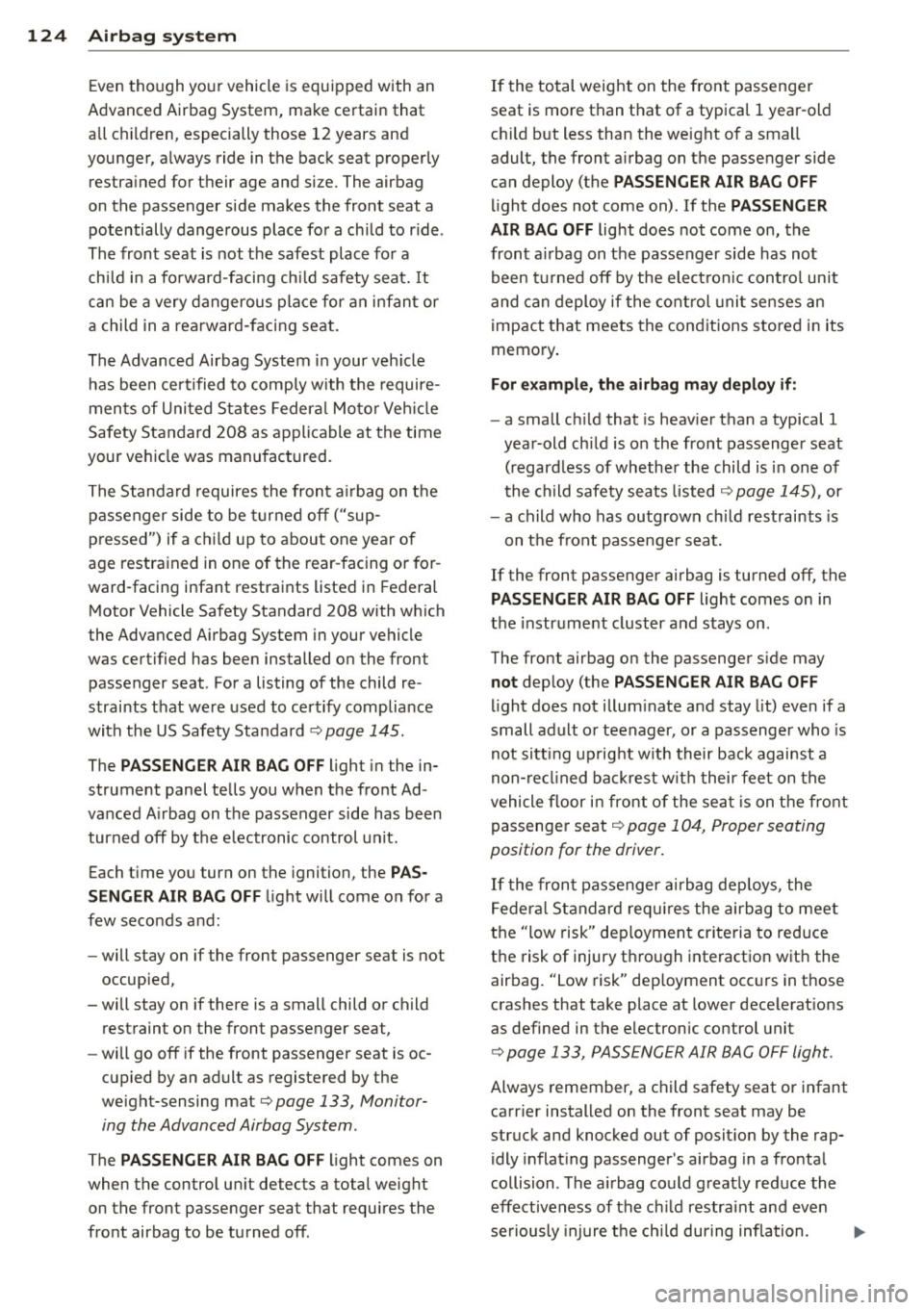
124 Airbag system
Even though your vehicle is equipped with an
Advanced Airbag System, make certain that
all chi ldren, especially those 12 years and
younger, a lways ride in the back seat properly
restrained for their age and size. The airbag
on the passenger side makes the front seat a potentially dangerous place for a ch ild to ride.
The front seat is not the safest place for a
child in a forward-facing child safety seat. It
can be a very dangerous place for an infant or
a child in a rearward-facing seat.
The Advanced Airbag System in your veh icle
has been certified to comply with the require
ments of United States Federal Motor Vehicle
Safety Standard 208 as applicable at the time
your vehicle was manufactured.
The Standard requires the front a irbag on the
passenger side to be turned off ("sup
pressed") if a child up to about one year of
age restrained in one of the rear-facing or for
ward -facing infant restraints listed in Federal
Motor Vehicle Safety Standard 208 with which
the Advanced Airbag System in your vehicle
was certified has been installed on the front passenger seat . For a listing of the child re
strai nts that we re used to certify compliance
with the US Safety Standard
r=v page 145.
The PASSENGER AIR BAG OFF light in the in
strument panel te lls you when the front Ad
vanced A irbag on the passenger side has been
turned off by the e lectronic control unit.
Each t ime you turn on the ignition, the
PAS
SENGER AIR BAG OFF
light will come on for a
few seconds and:
- will stay on if the front passenger seat is not
occupied,
- will stay on if there is a small child or child restraint on the front passenger seat,
- wi ll go off if the front passenger seat is oc
cupied by an adult as registered by the
weight-sensing mat
r=v page 133, Monitor
ing the Advanced Airbag System .
The PASSENGER AIR BAG OFF light comes on
when the control un it detects a total weight
on the front passenger seat that requires the
front airbag to be turned off.
If the total weight on the front passenge r
seat is more than that of a typica l 1 year -old
chi ld but less than the weight of a small
adult, the front airbag on the passenger side
can deploy (the
PASSENGER AIR BAG OFF
light does not come on). If the PASSENGER
AIR BAG OFF
light does not come on, the
front airbag on the passenger side has not
been turned off by the electronic con trol unit
and can deploy if the control unit senses an
impact that meets the cond itions stored in its
memory .
For example, the airbag may deploy if:
-a small ch ild that is heav ier than a typical 1
year-old ch ild is on the front passenger seat
( re gard less of whether the child is in one of
the child safety seats listed
r=v page 145), or
- a child who has outgrown ch ild restraints is
on the front passenger seat.
If the front passenger airbag is turned off, the
PASSENGER AIR BAG OFF light comes on in
the instrument cluster and stays on.
The front airbag on the passenger s ide may
not deploy (the PASSENGER AIR BAG OFF
light does not illum inate and stay lit) even if a
small adult or teenager, or a passenger who is
not sitting upright with their back against a
non-reclined backrest with their feet on the
vehicle floor in front of the seat is on the front
passenger seat
r=v page 104, Proper seating
position for the driver.
If the front passenger airbag deploys, the
Federal Standard requires the airbag to meet
the "low risk" deployment criteria to reduce
the risk of injury t hroug h interaction with the
airbag. "Low risk" deployment occurs in those
crashes that take place at lower dece lerat ions
as defined in the electronic control unit
r=v page 133, PASSENGER AIR BAG OFF light .
Always remember, a child safety seat or infant
carr ier installed on the front seat may be
struck and knocked out of posit ion by the rap
idly inflat ing passenger's airbag in a frontal
collision . The air bag could greatly reduce the
effectiveness of the ch ild restraint and even
seriously injure the child during inflation .
Page 127 of 280
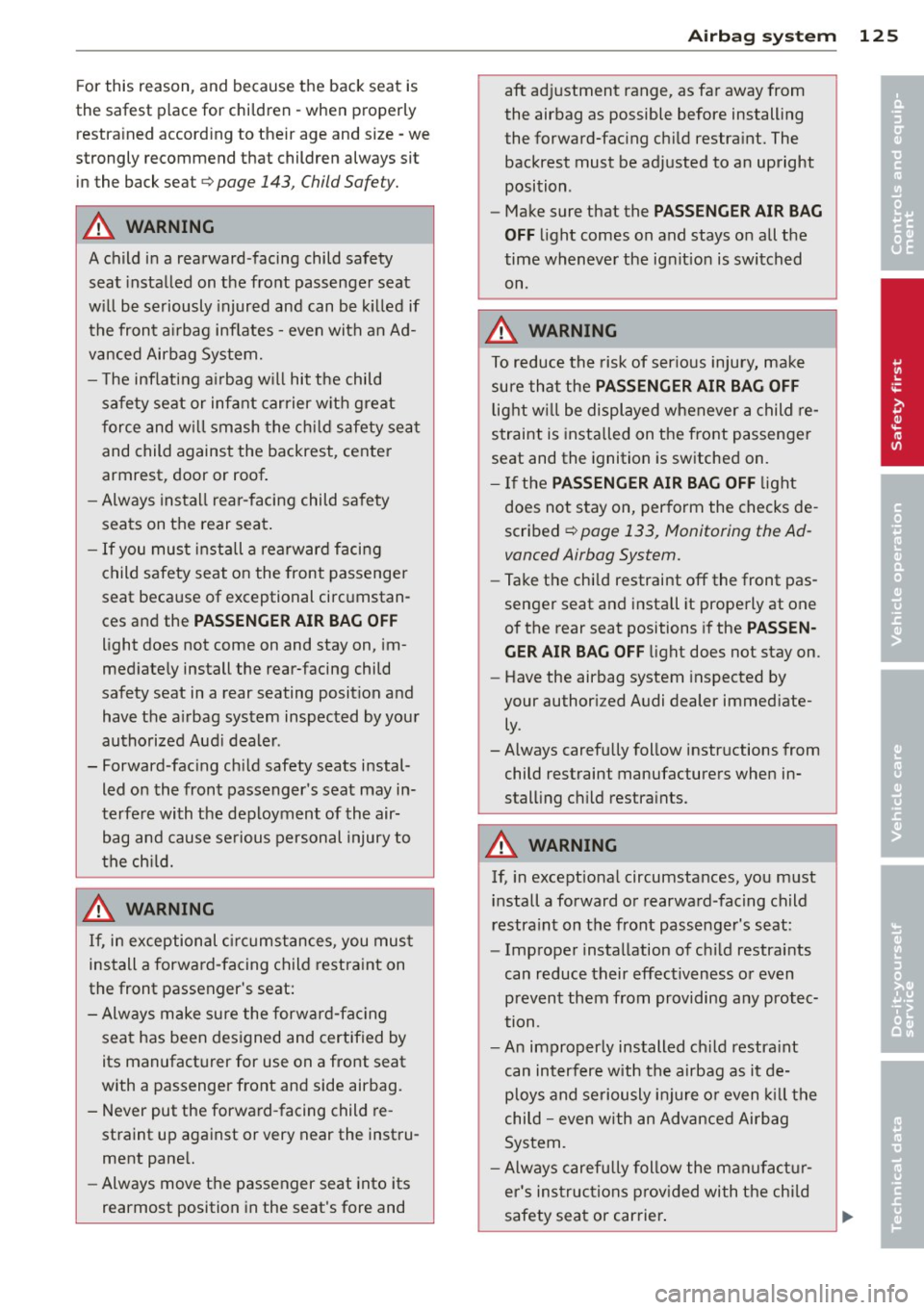
For this reason, and because the back seat is
the safest place for children - when properly restrained according to their age and size - we
strongly recommend that children always sit in the back seat
Q page 143, Child Safety.
A WARNING
-
A child in a rearward-facing child safety seat installed on the front passenger seat
w ill be seriously injured and can be k illed if
the front a irbag inflates - even with an Ad
vanced Airbag System.
- T he inflating a irbag w ill hit the child
safety seat or infant carrier with great
force and w ill smash the ch ild safety sea t
and child against the backrest, cente r
armrest, door or roof .
- Always install rear -facing child safety
seats on the rear seat.
- If you must install a rearward facing
child safety seat on the front passenger
seat because of exceptional circumstan
ces and the
PASSENGER AIR BAG OFF
light does not come on and stay on , im
med iately install the rear-facing child
safety seat in a rear seating posit ion and
have the a irbag system inspected by your
authorized Aud i dealer .
- Forward-fac ing ch ild safety seats instal
led on the front passenger's seat may in
terfe re with the deployment of the air
bag and cause se rious personal injury to
the ch ild.
A WARNING
If, in exceptional c irc umstances, you mus t
install a forwa rd-facing child restra int on
the front passenger's seat:
- Alw ays make sure the forw ard-fac ing
seat has been des igned and certified by
its manufacturer for use on a front seat
with a passenger front and side airbag.
- Never put the forward -facing child re
straint up aga inst or very near the instru
ment pane l.
- Always move the passenger seat into its
rearmost position in the seat's fore and
A irbag system 12 5
aft adjustment range, as far away from
the airbag as possible before installing
the forward-fac ing ch ild restraint. The
backrest must be adj usted to an upright
position .
- Make sure that the
PASSENGER AIR BAG
OFF
li ght comes on and stays on all the
time wheneve r the ignit ion is switched
on.
A WARNING
To reduce the risk of ser ious injury, make
su re that the
PASSENGER AIR BAG OFF
light w ill be displayed whenever a child re
straint is installed on the front passenger
seat and the ignition is switched on.
- If the
PASSENGER AIR BAG OFF light
does not s tay on, per form the checks de
scribed
Q page 133, Monitoring the Ad
vanced Airbag System.
- Take the chi ld restraint off the front pas
senger seat and install it properly at one
of the rear seat positions if the
PASSEN
GER AIR BAG Off light does not stay on.
- Have the airbag system inspected by
your author ized Audi dealer immed iate
ly .
-Always carefu lly follow instr uctions from
child restraint manufacturers when in
stall ing ch ild restra ints .
A WARNING
If, in except iona l circumstances, you must
install a forward or rearward-facing child
restra int on the front passenger's seat :
- Improper instal lation of ch ild restraints
can reduce their effect iveness o r even
prevent them from providing any protec
tion.
- An improper ly installed ch ild restra int
can interfere with the a irbag as it de
ploys and seriously i njure o r even kill the
child -even with an Adv ance d Airbag
System.
- Always carefu lly follow the manu factur
er 's ins truc tions p rov ided with the ch ild
safety seat or car rier . •
•
Page 128 of 280
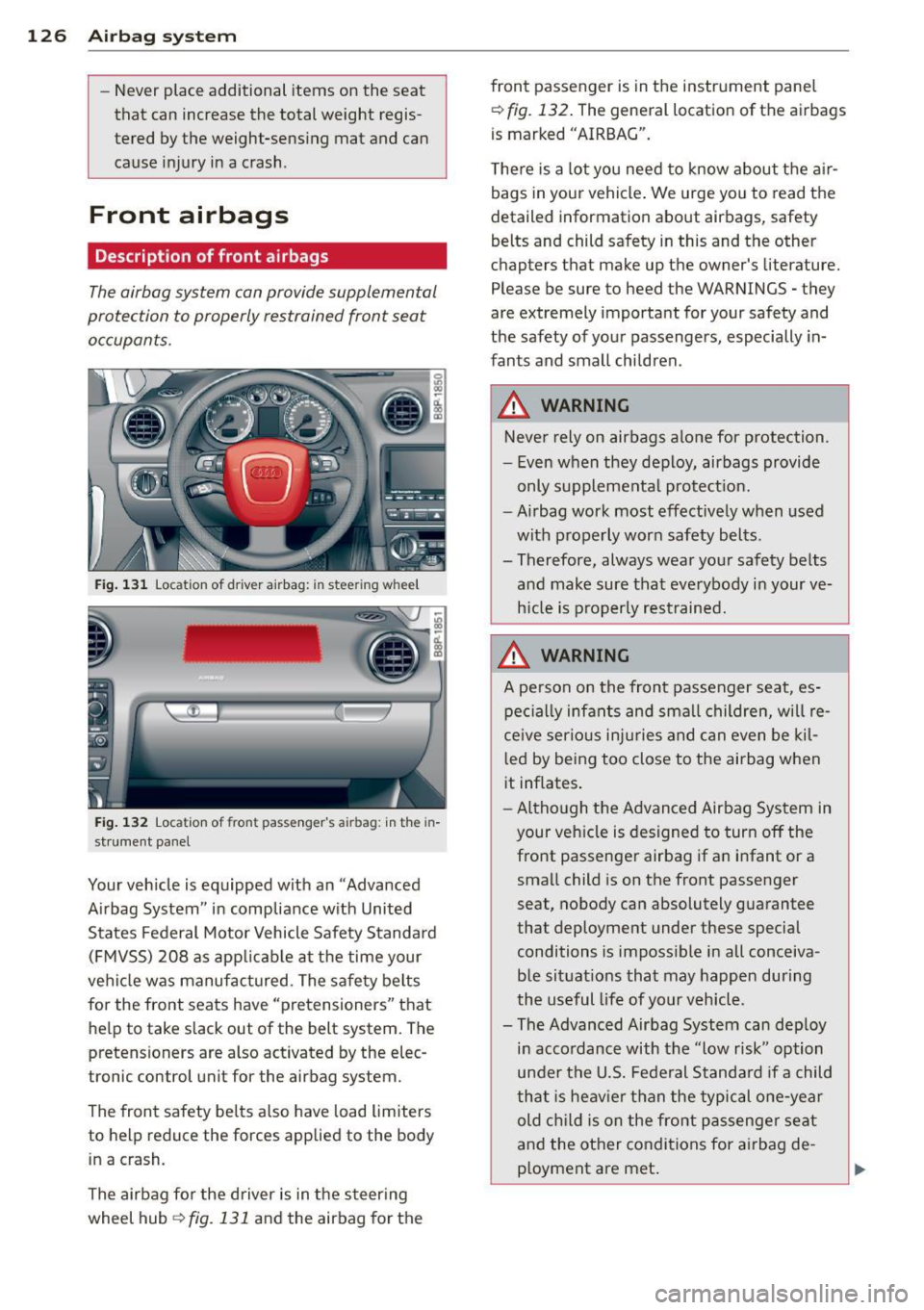
126 Airbag system
-Never place additiona l items on the seat
that can increase the total weight regis
tered by the weight-sensing mat and can
cause injury in a crash.
Front airbags
Description of front airbags
The airbag system can provide supplemental
protection to properly restrained front seat
occupants.
F ig . 131 Location of driver airbag: in steer ing whee l
Fig. 132 Location of front passenger's airbag: in the in
strument panel
Your veh icle is equipped with an "Advanced
A irbag System" in compliance with United
States Federal Motor Vehicle Safety Standard ( FM VSS) 208 as app licab le at the time your
ve hicl e was manufac tured. The safe ty belts
for the front seats have "pretensioners" that
he lp to take slack out of the belt system. The
pretensioners are also activated by the elec
tronic control unit for the airbag system.
The front safety be lts a lso have load limiters
to help reduce the forces applied to the body
i n a crash.
The airbag fo r the driver is in t he s teer ing
wheel hub¢
fig. 131 and the airbag for the front passenger is in the
instrument panel
¢
fig. 132 . The general location of the airbags
is marked "AIRBAG".
T here is a lot you need to know about the a ir
bags in your vehicle. We urge you to read the
detailed information about airbags, safety
belts and child safety in this and the other
chapters that make up the owner's literature.
Please be sure to heed the WARNINGS - they
are extremely important for your safety and
the safety of you r passengers, especially in
fants and small children.
_&. WARNING
Neve r rely on airbags a lone for p rotection.
- Even when they deploy, airbags provide
only supplemental protect ion.
- Ai rbag work most effectively when used
with properly worn safety belts.
- Therefore, always wear your safety belts
a nd make sure that eve rybody in your ve
h icle is p roperly restrained.
_&. WARNING
=
A pe rson on the front passenger seat, es-
pe cial ly infants and sma ll children, w ill re
ce ive ser io us in ju ries and can even be kil
l ed by being too close to the airbag when
it inflates .
- Altho ugh the Advanced Airbag Sys tem in
your vehicle is designed to tur n off the
front passenger airbag if a n in fant or a
sma ll child is on the front passenger
seat, nobody can absolutely guarantee
that deployment under these special
conditions is imposs ible in all conceiva
b le si tua tions that may happen during
the useful life of your v ehicle.
- The Advanced Airbag System can dep loy
i n acco rdance with the "low risk" option
unde r the U.S. Fede ral Standa rd if a child
t hat is heav ie r th an the typical o ne-year
old ch ild is on the front passenger seat
and the other conditions for ai rbag de
p loyment are met .
Page 129 of 280
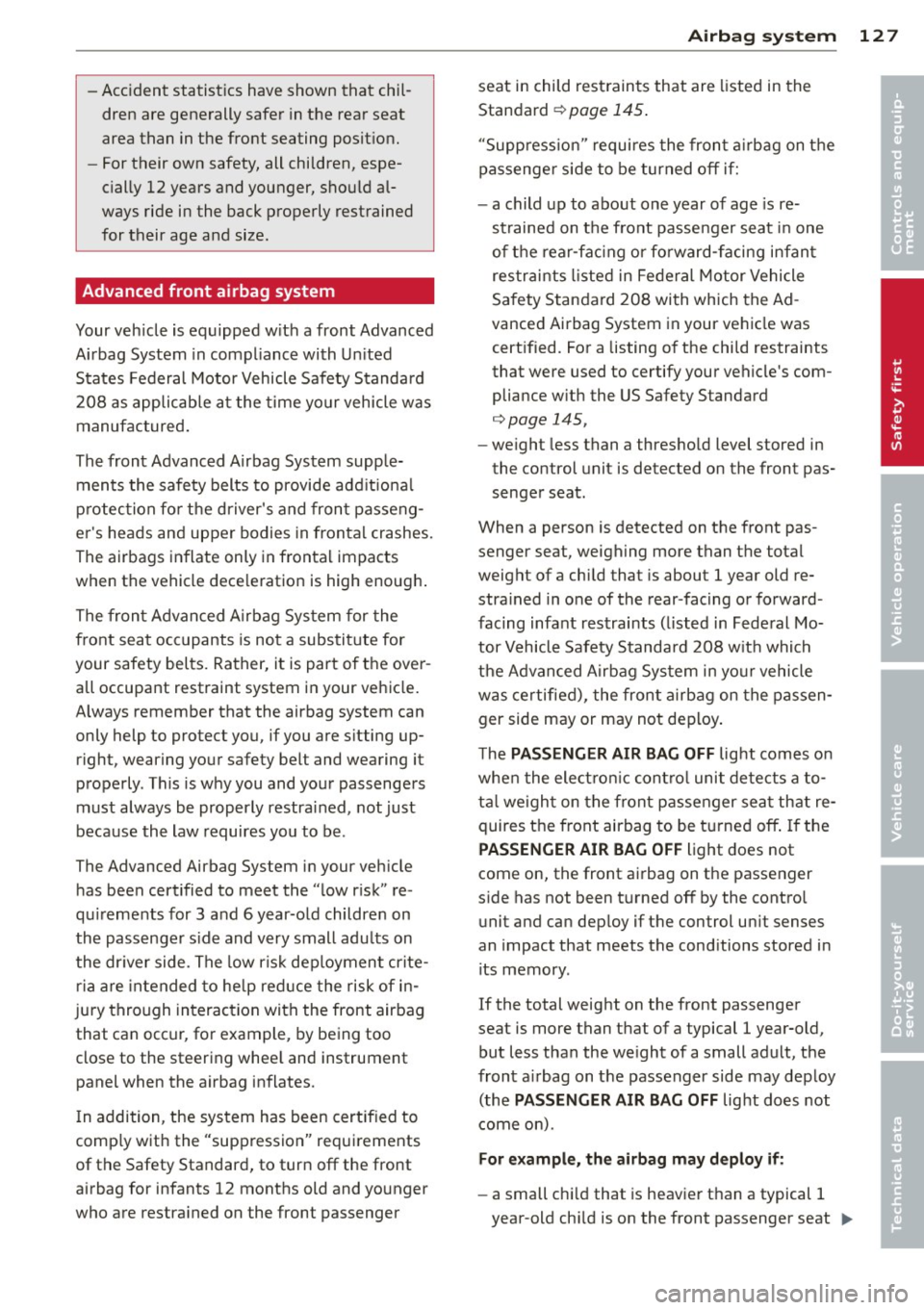
-Accident statistics have shown that chil
dren are generally safer in the rear seat
area than in the front seating posit ion.
- For their own safety, all children, espe
cially 12 years and younger, sho uld al
ways ride in the back properly restrained
for their age and size.
Advanced front airbag system
Your veh icle is equipped w ith a front Advanced
A irbag System in compliance with Un ited
States Federal Motor Vehicle Safety S tanda rd
208 as applicab le a t the time your vehicle was
manufac tured .
The front Advanced Airbag System supple ments the safety belts to provide add it iona l
p rotection fo r the driver's and fron t passeng
e r' s heads and upper bodies in fronta l crashes.
The airbags inflate only in frontal impacts
when the vehicle dece leration is high enough .
The fron t Advanced A irbag Sys tem for the
front seat occ upants is no t a substi tute for
your safety bel ts. Rather, it is part of the over
a ll occupa nt restraint system in your vehicle.
A lways remember that the airbag system can
only help to protect you, if you are s itting up
right, wearing your safety belt and wearing it
properly . This is w hy you and your passenge rs
must always be properly restrai ned, not just
because the law requires you to be .
The Advanced Airbag System i n your veh icle
has been certified to meet the " low r isk" re
qu irements for 3 and 6 year-o ld childre n on
the passenger s ide and very small adu lts on
the dr iver side. The low ris k dep loymen t cr ite
ria are intended to he lp red uce the risk of i n
j ury thro ugh in teraction with the front airbag
that can occ ur, fo r example, by being too
close to the steering whee l and instrument
panel when the airbag inflates.
I n addition, the sys tem has been certif ied to
comp ly with the "suppression" requirements
of the Safety Standard, to turn off the front
airbag for infants 12 months old and younger
who are restra ined on the front passenger
A irbag system 127
seat in child rest raints that are listed in the
Standard
¢ page 145 .
"Supp ress ion" requi res the fron t airbag on t he
passenge r sid e to be turned off if:
- a child up to abo ut one year of age is re
strained on the front passenger seat in one
of t he rear-fa cing o r fo rward -f a cing infan t
res traints listed in Federal Motor Vehicle
Safety Standard 208 with which the Ad
vanced Airbag System in your ve hicle was
cert ified. For a listing o f the chi ld restraints
that were used to certify your vehicle's com
pliance w ith the US Safety Standard
¢page 145,
- weight less than a thresho ld level stored in
the control unit is detected on the front pas
senge r seat.
When a person is detected on the front pas
senger seat, weighing more than the total
weight of a chi ld that is about 1 year old re
stra ined in one of the rear -fac ing or forward
facing infant restraints ( listed in Fede ral Mo
tor Vehicle Safety Standard 208 with whic h
t h e Advanced A irbag Sys tem in yo ur vehicle
was certified), the fron t airbag on the passen
ger side may or may not dep loy .
T he
PASSENGER AIR BAG OFF lig ht comes o n
whe n the elect ro nic cont ro l unit de tects a to
ta l we igh t on the front p assenger sea t that re
quires the front airbag to be t urned off .
If the
PASSENGER AIR BAG OFF light does not
come on, the front ai rbag on the passenger
s ide has not been t urned off by the contro l
u nit and can dep loy if the control un it senses
an impact that meets the cond itions stored i n
its memory .
If the total weight on the front passenger
seat is more than that of a typical 1 year-old,
but less than the we ight of a small adu lt, the
front a irbag on t he passenger side may dep loy
(the
PASSENGER AIR BAG OFF light does not
come on) .
For example, the airbag may deploy if:
-a small chi ld that is heav ie r than a typical 1
year-old ch ild is on the front passenger seat ..,. •
•
Page 130 of 280
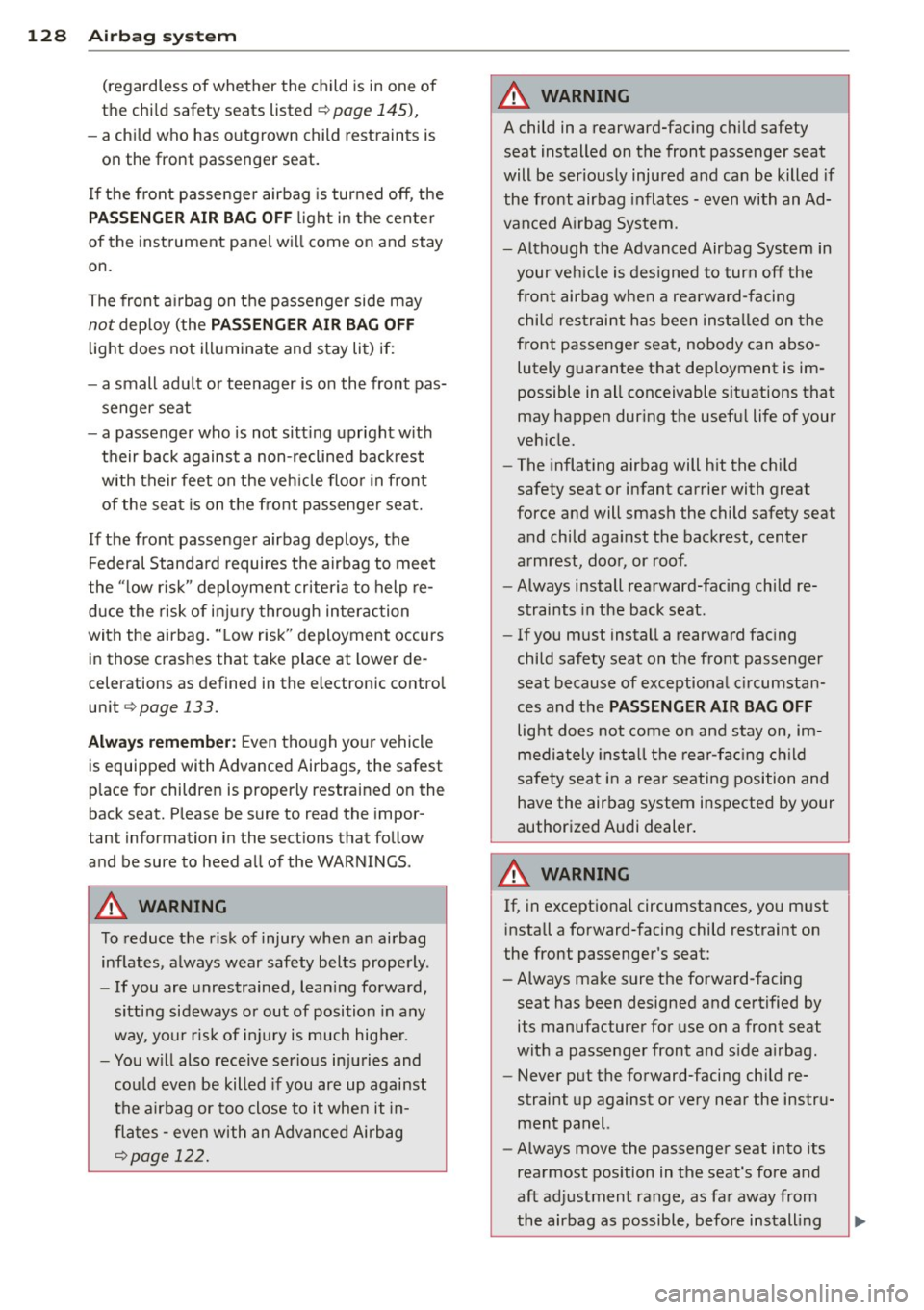
128 Airbag sys tem
(regar dless of whe ther the chil d is in one of
the ch ild safety seats listed
¢ pa ge 14 5),
- a chi ld w ho has outgrown child rest raints is
on the front passenger seat.
I f the front passenger airbag is turned
off , the
PASSEN GER AIR BA G OFF light in the cen ter
of the instrument pane l will come on and stay
on.
The front a irbag on the passenger side may
not deploy (the PA SSENGER AIR BAG OFF
light does not illuminate and stay lit) if:
- a small adu lt or teenager is o n the front pas
senger seat
- a passenger who is not sitt ing upr ight w ith
their back against a non-reclined backrest
with their feet on the veh icle floo r in front
of the sea t is on the front passenger seat.
I f the front passenger airbag deploys, the
F ederal Standard requires the airbag to meet
the " low risk " deployment criteria to help re
d uce the risk of in jury through in terac tion
with the airbag. " Low risk" deployment occurs
in those crashes that take place at lower de
celerations as defined in the e lectronic contro l
un it
q page 133.
Alwa ys remember: Even tho ugh you r vehicle
is equipped with Advanced Airbags, the safest
p lace for children is properly restrained on the
back seat. Please be sure to read the impo r
tant information in the sect ions that follow
and be sure to heed a ll of the WARNINGS .
A WARNING
To reduce the risk of injury when an airbag
inflates, a lways wear safety belts prope rly .
- If you are unrestrained, lean ing forward,
sitting sideways or out of position in any
way, your risk of injury is much higher.
- You w ill also receive serio us in juries and
cou ld even be killed if you are up against
the a irbag or too close to it when it in
fla tes - even with an Adv ance d Airbag
qpage 122.
A WARNING
A child in a rearward-fac ing ch ild safety
seat installed on the front passenger seat
will be serious ly injured and can be killed if
the front airbag inflates - even with an Ad
van ced A irbag System.
- Altho ugh the Advanced Airbag System in
your veh icle is designed to tur n
off the
front air bag when a rearward-facing
child res traint has been instal le d on the
front passenger seat, nobody can abso
lutely g uarantee that dep loyment is im
possible in all conceivable situations that
may happen dur ing the usefu l life of your
veh icle.
- The inflating airbag will h it the ch ild
safety seat or infant carrier with great
force and will smash the child safety seat
and child aga inst the backrest, center
armrest, doo r, or roof.
- Always install rearward-facing ch ild re
straints in the back seat.
- If you must install a rearward fac ing
child safety seat on the front passenger
seat because of exceptiona l circumstan
ces and t he
PASSENGER AIR BAG OFF
light does not come on and s tay on, im
mediately inst all the rear-fac ing c hild
safety seat in a rear seating position and
have the air bag system inspected by your
author ized Audi dealer .
A_ WARNING
If, in exceptiona l circumstances, you m ust
i nsta ll a forward-facing child restraint on
the front passenger's seat:
- Always make sure the forward-facing
seat has been designed and certified by its manufacturer for use on a front seat
with a passenger front and s ide a irbag .
- Never p ut the fo rward-facing child re
straint up against or very near the instru
ment panel.
- Always move the passenger seat into its
rearmost pos ition in the seat's fore and
aft ad justmen t range, as fa r away from
the airbag as possible, before ins talling